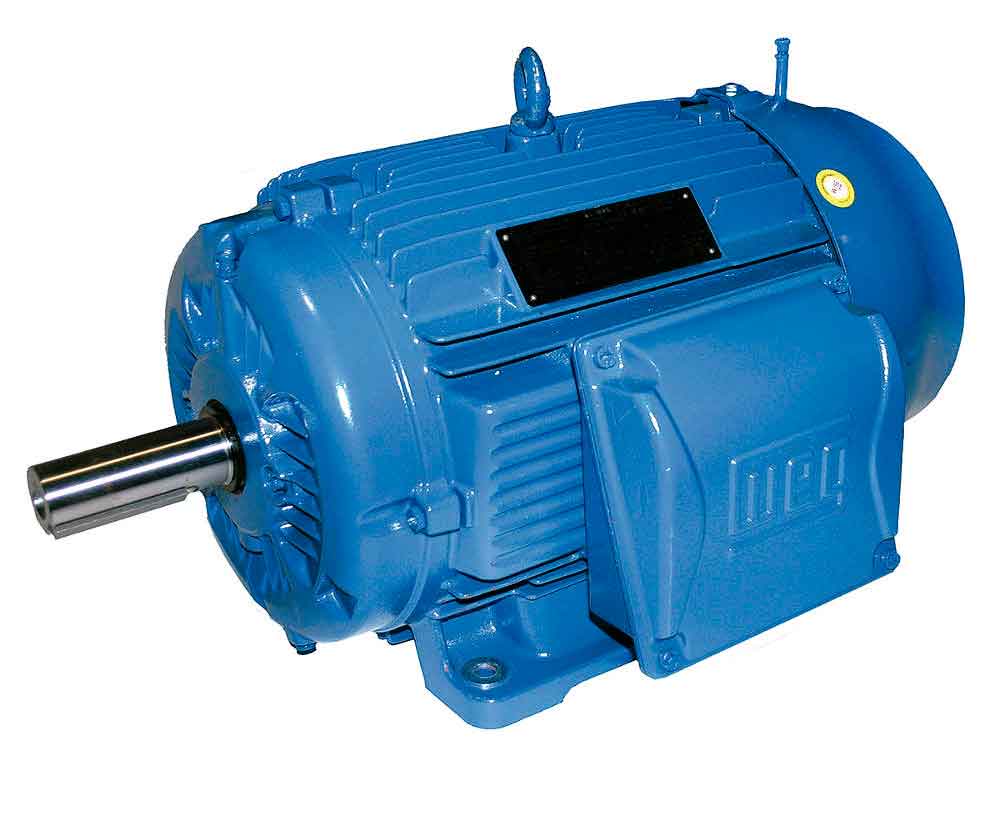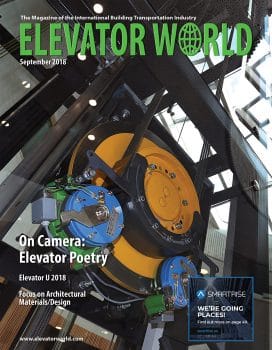NEC Requirements for Electric Motor Installations
Sep 1, 2018

Background of and details on two-stage overcurrent design to allow motor loads to start without compromising overload protection
When wiring a branch circuit or feeder for any electrical load, the electrician must provide short-circuit, ground-fault and overload protection. This ordinarily takes the form of a circuit breaker or fuse installed at the source of the circuit, in an entrance panel or a load center.
The rating of this overcurrent device is determined by the size and nature of the electrical load, and this rating, in turn, determines the size of the supply conductors to be used, subject to ambient temperature correction and adjustment factors (to be applied when more than three current-carrying conductors are present in a single conduit or cable or when wires are bundled).
Learning Objectives
After reading this article, you should have learned about:
♦ How overcurrent protection for motors differs from overcurrent protection for other electrical loads
♦ The important information found on the motor nameplate
♦ When full-load current as shown on a motor nameplate cannot be used in sizing overcurrent protection
♦ The meaning of locked rotor indicating code letters
♦ Specific motor controller and disconnect requirements
This is all spelled out in the National Electrical Code (NEC), which has jurisdiction in the U.S., Venezuela, Mexico and some other countries; the Canadian Electrical Code; the joint Australian and New Zealand Wiring Rules; mandates promulgated by the International Electrotechnical Commission for European countries and elsewhere; and in other codes enacted throughout the world.
Ampacity calculations, which determine the size of conductors required to supply any given load, are the most fundamental concept in all wiring installations. The basic idea is that electrical current flowing through any conductor produces heat according to the formula I2R, where I equals current in amperes, and R equals resistance in ohms. Resistance is dependent upon the material (usually copper or aluminum) and size. A larger-diameter wire has less resistance per unit length, and it is more capable of dissipating heat without dangerous temperature rise.
Excessive temperature events repeated over time will cause damage to the wire’s electrical insulation. Greater amounts of heat can cause wires to ignite nearby combustible material, so it is important that load size, wire size and overcurrent protection be accurately and consistently coordinated so a hazardous condition does not exist.
The calculations are straightforward. The ampacities of different conductor sizes in conjunction with wire material, insulation type and installation details (whether in conduit or aerial, for example) are given in NEC Tables 310.15(B)(16) through 310.60(C)(86). The American Wire Gauge number denotes all electrical wires of a given size and refers to the diameter of a conductor, but other properties (notably insulation type) are important, as well.
This procedure is applicable for ordinary electrical loads. Although the same tables are used, the choice and placement of overcurrent devices is radically different for motors. This is due to their high starting torque.
Most electrical loads, including common incandescent bulbs, draw more current for a second or so when starting, before stabilizing at the rated level. In the case of electric motors, this initial high current is considerably more pronounced compared to other loads. There are more amps, and the high-current period is of longer duration. The problem this causes is that if motor current protection is sized and placed in accordance with rules for non-motor loads (which draw less starting current than motor loads), typically, the breaker would trip before the motor obtained rated speed, rendering the installation unusable. The dilemma is that if the circuit size is increased with higher-rated (hence, less sensitive) breakers, the motor will not be protected against overload. This is not to mention the resulting increased installation cost.
Background
An ingenious two-stage overcurrent solution has been devised for motor loads to allow motor loads to start without compromising overload protection. This article describes this procedure in detail but will first detail some background information. NEC’s 2016 “Article 430, Motors, Motor Circuits, and Controllers” contains standards relevant to motor circuit design and installation. It is quite detailed (the longest NEC article, except for “Article 250, Grounding”). It is to be emphasized that, in doing a large motor circuit design and installation, it is necessary to refer to many non-motor NEC articles, such as “Article 110, Requirements for Electrical Installations” and Articles 320-399, which contain specifications, installation procedures and uses permitted and not permitted for all recognized cables and raceways.
An underlying requirement for all installations is that conductors that supply a single motor used in a continuous-duty application are to have an ampacity of not less than 125% of the motor full-load current rating.
Design
To successfully wire electrical motors, regardless of size, it is essential to look at the nameplate. NEC requires that all motors, with the exception of fractional DC motors 7 in. or less in diameter, have a nameplate that contains specified information. For most motors, this includes:
- Manufacturer’s name
- Rated volts and full-load current: for a multispeed motor, full-load current for each speed, except shaded-pole and permanent-split capacitor motors where amperes are required only for maximum speed.
- Rated frequency and number of phases (if an AC motor)
- Rated full-load speed
- Rated temperature rise, or, the insulation system class and rated ambient temperature.
- Time rating: 5, 15, 30 or 60 min., or continuous.
- Rated horsepower for a multispeed motor 1/8 hp or more: rated horsepower for each speed, except shaded-pole and permanent- split capacitor motors, rated horsepower is required only for maximum speed. Motors of arc welders are not required to be marked with horsepower ratings.
- Code letter or locked-rotor amperes if an AC motor rated 1/2 hp or more; on polyphase wound-rotor motors, the code letter is to be omitted.
- Design letter for design B, C or D motors
- Secondary voltage and full-load current if a wound-rotor induction motor
- Field current and voltage for DC excited synchronous motors
- Winding: straight shunt, stabilized shunt, compound or series, if a DC motor
- A motor provided with a thermal protector complying with 430.32(A)(2) or (B)(2) is to be marked “Thermally Protected.”
- A motor complying with 430.32(B)(4) is to be marked “Impedance Protected.”
- Motors equipped with electrically powered condensation- prevention heaters are to be marked with the rated heater voltage, number of phases and rated power in watts.
The nameplate is generally made of steel and riveted to the motor enclosure, so it is unlikely to be missing. However, in an older motor, due to wear, the marking may be difficult to read. If the nameplate is lightly sanded and a bright light directed at an oblique angle across it, the lettering can usually be made legible with the aid of a magnifying glass.
For most installations, the most important information on the nameplate is the rated horsepower. Unlike other types of electrical loads, horsepower (rather than full-load current) is used to size the circuit and choose short-circuit, ground-fault and overload protection.
The code letter or locked-rotor amperes make up another important bit of information on the nameplate. This is provided for a motor rated 1/2 hp or more. (It is to be omitted on polyphase wound- rotor motors.) Locked-rotor amperes refers to the amount of current drawn when the rotor cannot turn. This could be due to seized bearings, a binding load or one too heavy for the motor, or power- transmission malfunction. Another cause could be reduced voltage or dropped phase at the motor terminals.
The locked-rotor-indicating code letters are clarified in NEC’s 2016 “Table 430.7(B), Locked-Rotor Indicating Code Letters.” In sections A-V, excluding I, each letter stands for a range of kilovolt- amperes per horsepower with locked rotor. These values are an inverse measure of the amount of impedance exhibited by the motor in question with locked rotor. The minimum kilovolt-amperes per horsepower with locked rotor is denoted by code letter A, corresponding to a range of values of 0-3.14. This would indicate a relatively high-impedance motor. At the other end of the scale is code letter V, denoting a motor with locked rotor power of 22.4 kilovolt-amperes and up per horsepower. This would indicate a relatively low-impedance motor.
As stated above, non-motor loads are protected by a single overcurrent device located at the upstream end of the branch circuit. The device protects the branch- circuit conductors from excessive current caused by short-circuit or ground-fault. It also protects this wiring and the connected equipment from damage caused by overload. To prevent a motor circuit from tripping out before the motor reaches operating speed and the current level stabilizes, the branch-circuit protection in a motor circuit is permitted to be much higher than for a non-motor load. This higher-level (less-sensitive) overcurrent device will protect the branch-circuit supply conductors from damage in the event of a sudden, catastrophic line-to-line or line-to-ground fault, but it will not trip out in the event of a lower-level, slower- acting overload at the motor.
Consequently, separate overload protection is required at the motor. This is what is meant by two-stage overcurrent protection, which all electric motors are required to have.
Typically, for small motors, the electrician, code book in hand, designs in the field and builds the entire circuit, including sizing conductors and the complete overcurrent system, along with whatever controllers and disconnects are needed. Larger motor circuits are usually designed by an electrical engineer prior to construction. All details, including conductor and raceway sizes, routing, overcurrent protection ratings and so on, are shown on plans, and (preferably) checked by a third party and in consultation with the manufacturer.
In all cases, the conductor sizes and overcurrent system types and ratings can be derived from the 2016 NEC code, especially Article 430. (“Article 440, Air-Conditioning and Refrigerating Equipment” and “Article 445, Generators,” cover related topics). This may require considerable scrutiny and experience, since the code is not a how-to book or manual for untrained persons, but rather a volume containing technical specifications that presupposes background knowledge, as well as mathematical proficiency. Calculus and trigonometry are not generally needed, but a lot of algebraic equations are part of the picture, and the ability to interpret tables and accurately extract and apply data is essential. One error can mean a fiery inferno down the road.
The first task in designing a motor circuit, if the motor is suitable for the load, anticipated (intermittent or continuous) duty and ambient conditions have been chosen, is to size the motor overload protection. For continuous-duty motors rated at more than 1 hp, a common expedient is a separate overload device. This is sized in accordance with the service factor and temperature rise. It is to be selected to trip, or it is rated at no more than 125% of the motor nameplate full-load current rating for motors marked with a service factor of 1.15 or greater, or marked with a temperature rise of 40°C. or less. For all other motors, the device is to be selected to trip or rated at no more than 115% of the motor nameplate full-load current.
Other alternative methods for overload protection of continuous-duty motors rated more than 1 hp are permitted. One of these is the thermal protector. This thermal protector is integral with the motor and must be approved for use with it. It protects on the basis that it will prevent dangerous overheating of the motor due to overload and failure to start. The ultimate trip current of a thermally protected motor is not to exceed the following percentages of motor full-load current given in Tables 430.248, 430.249 and 430.250:
- Motor full-load current 9 A or less: 170%
- Motor full-load current from 9.1 to, and including, 20 A: 156%
- Motor full-load current greater than 20 A: 140%
If the motor current-interrupting device is separate from the motor, and its control circuit is operated by a protective device integral with the motor, it is to be arranged so that the opening of the control circuit will result in interruption of current to the motor.
Notice that in the first method for overload protection, where a separate overload device is used, the nameplate full-load current is used. In the second method, in contrast, the full-load current is not taken from the nameplate, but is extracted from Tables 430.248, 249 and 250. These three tables are found at the end of Article 430 and provide a different method for finding full-load currents for motors. In all cases throughout Article 430, it is important to use the correct method for ascertaining full-load current. There are actually four of these tables if Table 430.247 (for DC motors) is included. Table 430.248 is for single-phase AC motors. Table 430.249 is for two-phase AC motors, a rarely used form of electrical distribution. Table 430.250 is for three-phase AC motors, a very common application.
Another alternative for overload protection is a protective device integral with the motor. This is permitted when the motor is part of an approved assembly that does not normally subject the motor to overloads.
Where the motor is larger than 1,500 horsepower, a protective device having embedded temperature detectors that cause current to the motor to be interrupted when the motor attains a temperature rise greater than marked on the nameplate in an ambient temperature of 40°C is permitted to perform the protective function.
“Part IV, Motor Branch-Circuit Short-Circuit and Ground-Fault Protection” specifies devices and their ratings intended to protect the motor and peripherals, including branch-circuit conductors, from damage due to short-circuits and ground faults. The current ratings are permitted to be much higher than for non-motor circuits. Otherwise, they would trip during startup. It is clearly stated that for all motors, the branch-circuit short-circuit and ground-fault protective device is to be capable of carrying the starting current of the motor.
Table 430.52 facilitates this calculation. The left column of this essential table consists of a list of seven types of motors. The top row consists of four types of overcurrent device. The cells of the table contain percentages of full-load current, specifying the maximum ratings or settings of the branch-circuit short-circuit and ground-fault protective devices. The values are surprisingly high. For example, for a Design B energy-efficient motor, if an instantaneous trip breaker is used, the setting may be 1,100% of the full-load current. Here, again, the full-load currents are to be taken from Tables 430.247-430.250, as opposed to the motor nameplate.
The 2016 NEC code requires all motors to have controllers and disconnects. For some motors, they can be the same device, or they may be in the same enclosure. For small motors, the circuit breaker in the entrance panel or load center, or a cord-and-plug connection, will suffice.
Motor controllers are covered in Part VII, and motor disconnecting means are covered in Part IX of Article 430. The branch-circuit disconnecting means is permitted to serve as the controller for stationary motors of 1/8 hp or less that are normally left running and constructed to not be damaged by overload or failure to start, such as by clock motors. For portable motors rated at 1/3 hp or less, the controller is permitted to be an attachment plug and receptacle, or cord connector. In all cases, the controller must be capable of starting and stopping the motor and be capable of interrupting locked-rotor current of the motor.
A stationary motor rated at 2 hp or less and operating at 300 V or less may have a controller that consists of either a general-use switch having an ampere rating not less than twice the full-load current rating of the motor, or, on AC circuits, a general-use snap switch suitable only for use on AC (not a general-use AC/DC snap switch) where the motor full-load current is not more than 80% of the ampere rating of the switch.
The 2016 NEC code states that the controller is not required to open all the conductors to the motor, unless it also serves as the disconnecting means, in which case it is to open all ungrounded conductors to the motor.
The disconnecting means must be capable of disconnecting motors and controllers from the circuit. Each controller must have its own disconnecting means, which must be in sight from the controller location. (There are some exceptions to both of these requirements. For example, when a group of coordinated controllers drives several parts of a single machine, one disconnect can serve all controllers.)
The controller disconnecting means may serve as the disconnecting means for the motor if it is in sight of the motor location and the driven machinery location. The disconnecting means is to open all ungrounded supply conductors and is to be designed so that no pole can be operated independently. The disconnecting means is permitted to be in the same enclosure with the controller and is to be designed so that it cannot be closed automatically. It must plainly indicate whether it is open or closed. At least one disconnecting means is to be readily accessible.
For motor circuits rated 1,000 V or less, the disconnecting means is to have an ampere rating no less than 115% of the full-load current rating of the motor.
Part X of the 2016 NEC Article 430 covers adjustable-speed drive systems. It provides that circuit conductors supplying power-conversion equipment are to have an ampacity not less than 125% of the rated input current to the power-conversion equipment. Individual motor overloads are to be provided for a multiple-motor application.
This article has examined some of the basic NEC requirements for motor installations. Further requirements, which modify those in Article 430, are found in “Article 620, Elevators, Dumbwaiters, Escalators, Moving Walks, Platform Lifts and Stairway Chairlifts.” In this article, there is extensive coverage of group installations, which are quite common in high-rise buildings with elevator
service. Of particular importance are requirements regarding permitted wiring methods in the machine room, hoistway and car. Section 620.21(A)(4) discusses wiring methods on the counterweight assembly, and Part V covers the traveling cable.
Disclaimer
It is to be emphasized that the information in this article is an overview, intended to introduce some motor design and installation requirements from a point of view of safety. If a new installation or repair work is contemplated, the full text of the code should be reviewed to ensure full compliance and a safe final product.
Learning-Reinforcement Questions
Use the below learning-reinforcement questions to study for the Continuing Education Assessment Exam available online at www.elevatorbooks.com or on p.191 of this issue.
♦ How is overcurrent protection sized for motors?
♦ How are conductor sizes determined for motors?
♦ What is the purpose of a motor controller?
♦ What are the requirements for locating a motor disconnect?
♦ How is the circuit size determined for an adjustable-speed motor?
Get more of Elevator World. Sign up for our free e-newsletter.








